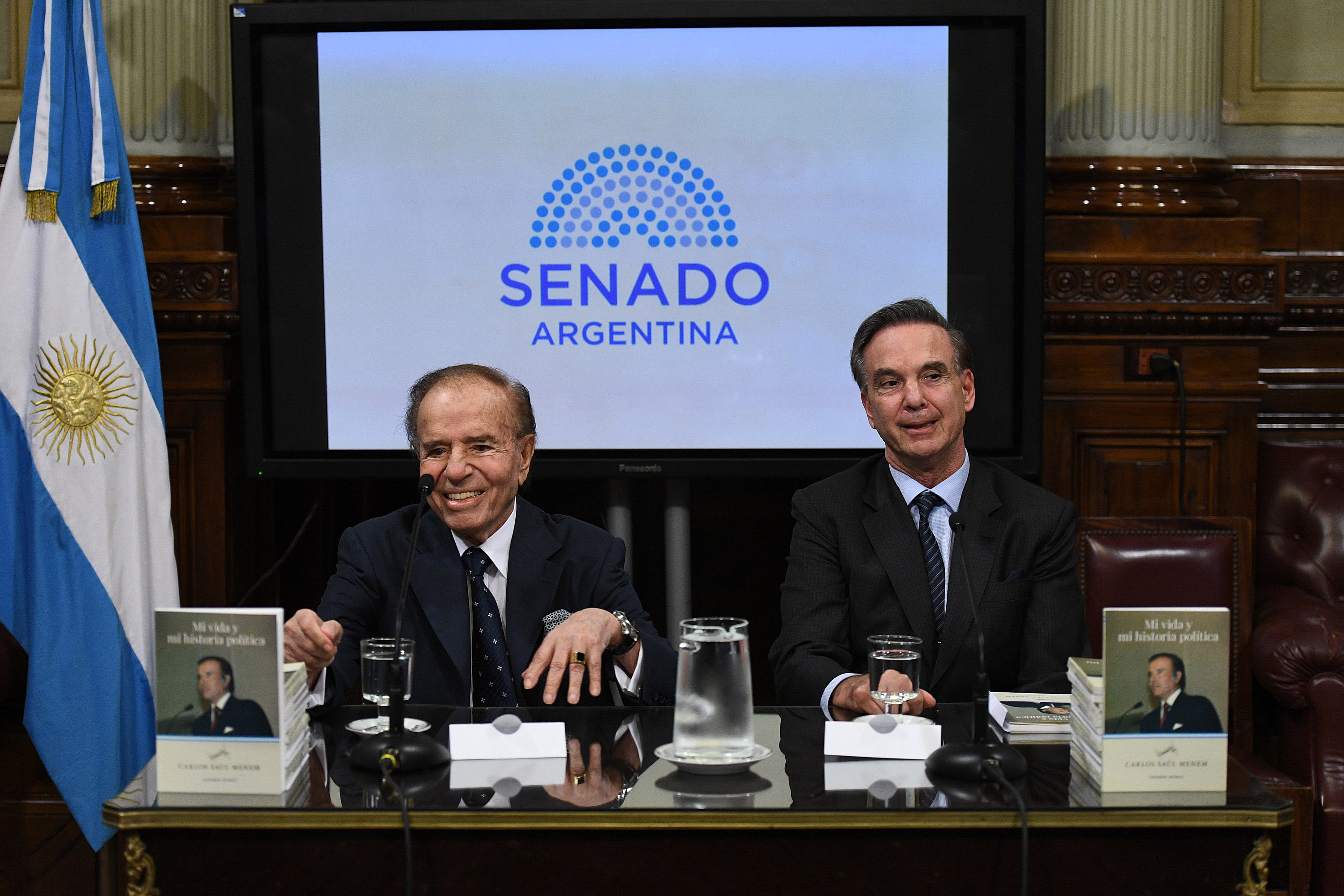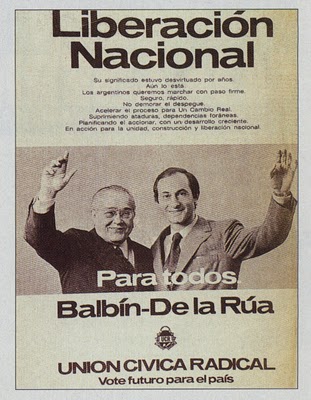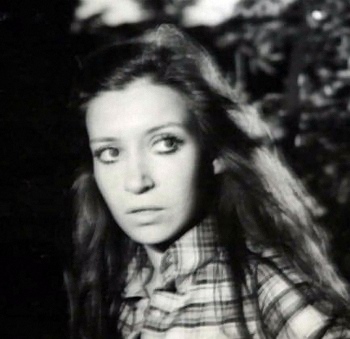|
Menemism
Federal Peronism ( es, Peronismo Federal), also known as Dissident Peronism ( es, Peronismo Disidente) and Menemism ( es, Menemismo), are the informal names given to a conservative political alliance between Justicialist Party figures, currently identified mostly by its opposition to ruling Kirchnerism, the left-wing faction. The term "Federal Peronism," as opposed to "metropolitan Peronism" (mainly from Greater Buenos Aires), was informally used since the 1980s to identify the more traditional and conservative Peronists from the Provinces of Argentina, whose governors grew in number and influence during the administration of President Carlos Menem. "Dissident Peronism" is more properly used to refer to the Peronist opposition to the administrations and party leadership of left-leaning Néstor Kirchner and Cristina Fernández de Kirchner. The term gained currency since the 2008 Argentine government conflict with the agricultural sector, when a number of party leaders, governo ... [...More Info...] [...Related Items...] OR: [Wikipedia] [Google] [Baidu] |
Justicialist Party
The Justicialist Party ( es, Partido Justicialista, ; abbr. PJ) is a major political party in Argentina, and the largest branch within Peronism. Current president Alberto Fernández belongs to the Justicialist Party (and has, since 2021, served as its chairman), as well as former presidents Juan Perón, Héctor Cámpora, Raúl Alberto Lastiri, Isabel Perón, Carlos Menem, Ramón Puerta, Adolfo Rodríguez Saá, Eduardo Camaño, Eduardo Duhalde, Néstor Kirchner, and Cristina Fernández de Kirchner. Justicialists have been the largest party in Congress almost consistently since 1987. Founded by Juan Perón, it was previously called the Peronist Party after its founder. It is overall the largest party in Congress; however, this does not reflect the divisions within the party over the role of Kirchnerism, the left-wing populist faction of the party, which is opposed by the dissident Peronists (also known as Federal Peronism or Menemism), the conservative faction of the party. Hist ... [...More Info...] [...Related Items...] OR: [Wikipedia] [Google] [Baidu] |
Miguel Ángel Pichetto
Miguel Ángel Pichetto (born 24 October 1950) is an Argentine lawyer and Federal Peronism, conservative peronist politician. He is Auditor General of the Nation. He was Argentine Senate, National Senator for Río Negro Province for eighteen years and was the vice-presidential candidate of Juntos por el Cambio. Ideologically, he considers himself a Peronist, republicanism, republican and capitalism, capitalist, while also an admirer of Julio Argentino Roca and Carlos Saúl Menem administrations. Biography Pichetto was born in Banfield, Buenos Aires. He earned a law degree at the National University of La Plata in 1976 and relocated to Río Negro Province, where he served as counsel for ''Hierro Patagónico Sierra Grande'', a pig iron smelter, and for the Provincial Government. Political career He was elected to the Sierra Grande, Río Negro, Sierra Grande City Council in 1983, and in 1985 became mayor of the city, serving until 1987. Pichetto married María Teresa Minassian, with ... [...More Info...] [...Related Items...] OR: [Wikipedia] [Google] [Baidu] |
Congreso Nacional Justicialista Potrero De Los Funes
() is a musical band from Chile. Founded in 1969 in Quilpué, it is a highly acclaimed band with over 50 years of experience fusioning and developing Latin American music. Began their career in the late 1960s linked to New Chilean Song movement, however with the advent of the military dictatorship and cultural constraints of the time, added to the great instrumental vocation of its members, they evolved into a progressive rock style, and later to a fusion sound that incorporated elements also from jazz fusion, contemporary music, pop music, and world music, in a style named by them as ''The New Latinamerican Music''. It is one of the most important bands in the history of the Chilean music, both for his refined musical compositions with lyrics of social and ethnic content, as well as by the good reception of the national and international public and critics. Formed together with Los Jaivas and Los Blops, is one of the cornerstones in the new Chilean progressive sound and t ... [...More Info...] [...Related Items...] OR: [Wikipedia] [Google] [Baidu] |
Fernando De La Rúa
Fernando de la Rúa (15 September 19379 July 2019) was an Argentine politician and a member of the Radical Civic Union (UCR) political party who served as President of Argentina from 10 December 1999 to 21 December 2001. De la Rúa was born in Córdoba; he entered politics after graduating with a degree in law. He was elected senator in 1973 and unsuccessfully ran for the office of Vice President as Ricardo Balbín's running mate the same year. He was re-elected senator in 1983 and 1993, and as deputy in 1991. He unsuccessfully opposed the pact of Olivos between President Carlos Menem and party leader Raúl Alfonsín, which enabled the 1994 amendment of the Argentine Constitution and the re-election of Menem in 1995. De la Rúa was the first chief of government of Buenos Aires to be elected by popular vote, a change introduced by the amendment of the Constitution. He expanded the Buenos Aires Underground, adding new stations to Line D, starting the expansion of Line B, and est ... [...More Info...] [...Related Items...] OR: [Wikipedia] [Google] [Baidu] |
President Of Argentina
The president of Argentina ( es, Presidente de Argentina), officially known as the president of the Argentine Nation ( es, Presidente de la Nación Argentina), is both head of state and head of government of Argentina. Under Constitution of Argentina, the national constitution, the president is also the Head of government, chief executive of the Government of Argentina, federal government and commander-in-chief of the Armed Forces of the Argentine Republic, armed forces. Throughout Argentine history, the List of heads of state of Argentina, office of head of state has undergone many changes, both in its title as in its features and powers. Current president Alberto Fernández was sworn into office on 10 December 2019. He succeeded Mauricio Macri. The constitution of Argentina, along with several constitutional amendments, establishes the requirements, powers, and responsibilities of the president and term of office and the method of election. History The origins of Argentina ... [...More Info...] [...Related Items...] OR: [Wikipedia] [Google] [Baidu] |
December 2001 Riots In Argentina
The December 2001 crisis, sometimes known as the Argentinazo (), was a period of civil unrest and rioting in Argentina, which took place during December 2001, with the most violent incidents taking place on 19 and 20 December in the capital, Buenos Aires, Rosario and other large cities around the country. It was preceded by a popular revolt against the Argentine government, rallying behind the motto "All of them must go!" (), which caused the resignation of then-president Fernando de la Rúa, giving way to a period of political instability during which five government officials performed the duties of the Argentinian presidency. This period of instability occurred during the larger period of crisis known as the Argentine great depression, an economic, political, and social crisis that lasted from 1998 until 2002. The December 2001 crisis was a direct response to the government's imposition of "Corral" policies () at the behest of economic minister Domingo Cavallo, which restr ... [...More Info...] [...Related Items...] OR: [Wikipedia] [Google] [Baidu] |
2008 Argentine Government Conflict With The Agricultural Sector
The 2008 Argentine agrarian strike refers to the conflict between the Argentine national government and the 4 entities that represented the agriculture sector. The crisis began in March 2008 with four agricultural sector employers organizations taking direct action such as road blocks to protest against the decision of the government of Cristina Fernández de Kirchner to raise export taxes on soybeans and sunflower. The subsequent political upheaval has seen elements of the ruling Front for Victory speak out against the government and the resignation of Economy Minister Martín Lousteau. History In March 2008, Fernández de Kirchner's government introduced a new sliding-scale taxation system for agricultural exports, effectively raising levies on soybean exports to 44% from 35% at the time of the announcement. The aim was to raise government funds for social investment by increasing the government's share of returns from rising world grain prices, and also to reduce domestic food ... [...More Info...] [...Related Items...] OR: [Wikipedia] [Google] [Baidu] |
Cristina Fernández De Kirchner
Cristina Elisabet Fernández de Kirchner (; born 19 February 1953), often referred to by her initials CFK, is an Argentine lawyer and politician who has served as the Vice President of Argentina since 2019. She also served as the President of Argentina from 2007 to 2015 and the first lady during the tenure of her husband, Néstor Kirchner. She was the second female president of Argentina (after Isabel Perón) and the first elected female president of Argentina. Ideologically, she identifies herself as a Peronist and a progressive, with her political approach called Kirchnerism.BBC News. 18 April 2006Analysis: Latin America's new left axis. Born in La Plata, Buenos Aires Province, she studied law at the University of La Plata, and moved to Patagonia with her husband Néstor Kirchner upon graduation. She was elected to the provincial legislature; her husband was elected mayor of Río Gallegos. She was elected national senator in 1995, and had a controversial tenure, while ... [...More Info...] [...Related Items...] OR: [Wikipedia] [Google] [Baidu] |
Néstor Kirchner
Néstor Carlos Kirchner (; 25 February 195027 October 2010) was an Argentine lawyer and politician who served as the President of Argentina from 2003 to 2007, Governor of Santa Cruz Province from 1991 to 2003, Secretary General of UNASUR and the first gentleman during the first tenure of his wife, Cristina Fernández de Kirchner. He was President of the Justicialist Party from 2008 to 2010. Ideologically, he identified himself as a Peronist and a progressive, with his political approach called Kirchnerism.BBC News. 18 April 2006Analysis: Latin America's new left axis./ref> Born in Río Gallegos, Santa Cruz, Kirchner studied law at the National University of La Plata. He met and married Cristina Fernández at this time, returned with her to Río Gallegos at graduation, and opened a law firm. Commentators have criticized him for a lack of legal activism during the Dirty War, an issue he would involve himself in as president. Kirchner ran for mayor of Río Gallegos in 1987 and ... [...More Info...] [...Related Items...] OR: [Wikipedia] [Google] [Baidu] |
List Of Governors In Argentina
Argentina is subdivided into twenty-three provinces, each of it counting with its own governor. The country is organized under a federal system, so each province has its own constitution, and the powers and regulations of each governor vary. Buenos Aires is not a province, nor is it part of Buenos Aires Province. The 1994 amendment of the Constitution of Argentina made it an autonomous city, with its own constitution, ruled by an elected mayor (Buenos Aires City Chief of Government). A governor may be removed by the national government in the case of great turmoil, or if the legitimate governor had been illegally removed, for example, by a coup d'état. The President of Argentina would ask in this case for the Federal intervention of the province, which must be approved by the National Congress of Argentina. Gallery List of current provincial heads of government See also * List of female provincial governors in Argentina * List of provincial legislatures in Argentina ... [...More Info...] [...Related Items...] OR: [Wikipedia] [Google] [Baidu] |
Provinces Of Argentina
Argentina is subdivided into twenty-three federated states called provinces ( es, provincias, singular ''provincia'') and one called the autonomous city (''ciudad autónoma'') of Buenos Aires, which is the federal capital of the republic ( es, Capital Federal, links=no) as decided by the National Congress of Argentina, Argentine Congress. The provinces and the capital have their own constitutions, and exist under a federalism, federal system. History During the Argentine War of Independence, War of Independence the main cities and their surrounding countrysides became provinces though the intervention of their Cabildo (council), ''cabildos''. The Anarchy of the Year XX completed this process, shaping the original thirteen provinces. Jujuy Province, Jujuy seceded from Salta Province, Salta in 1834, and the thirteen provinces became fourteen. After seceding for a decade, Buenos Aires Province accepted the 1853 Constitution of Argentina in 1861, and its capital city was made ... [...More Info...] [...Related Items...] OR: [Wikipedia] [Google] [Baidu] |
Greater Buenos Aires
Greater Buenos Aires ( es, Gran Buenos Aires, GBA), also known as the Buenos Aires Metropolitan Area ( es, Área Metropolitana de Buenos Aires, AMBA), refers to the urban agglomeration comprising the Autonomous City of Buenos Aires and the adjacent 24 '' partidos'' (districts) in the Province of Buenos Aires. Thus, it does not constitute a single administrative unit. The conurbation spreads south, west and north of Buenos Aires city. To the east, the River Plate serves as a natural boundary. Urban sprawl, especially between 1945 and 1980, created a vast conurbation of 9,910,282 inhabitants in the 24 conurbated ''partidos'', as of 2010, and a total of 12,801,365 including the City of Buenos Aires, a third of the total population of Argentina and generating more than half of the country's GDP. History The term ''Gran Buenos Aires'' ("Greater Buenos Aires") was first officially used in 1948, when Governor of Buenos Aires Province Domingo Mercante signed a bill delineating as ... [...More Info...] [...Related Items...] OR: [Wikipedia] [Google] [Baidu] |








